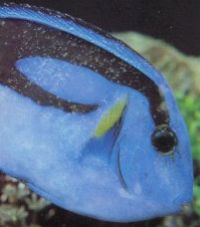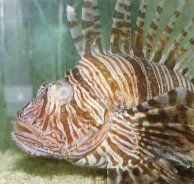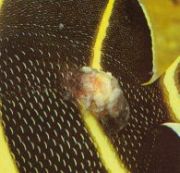 Common Causes Of Disease
Common Causes Of Disease
The cause of most disease in marine fishes and invertebrates is simply poor environmental factors i.e. poor water quality. On the whole marine fishes are extremely disease resistant, but when things go wrong in a marine system livestock can deteriorate rapidly.
What Constitutes Poor Water Quality & Conditions?
- pH fluctuations
- high, low or rapid fluctuations in salinity (poor husbandry)
- high ammonia readings
- high nitrite readings
- excessive nitrate
- high, low or fluctuating temperatures
Disease Prevention - Steps To Take
- Ensure good water quality
- do regular partial water changes, 15 - 20% every two weeks or 30 percent monthly
- this is for fairly well stocked systems, lightly stocked systems can get away with less
- use a good protein skimmer to remove excess wastes quickly
- Do not overfeed your livestock
- overfeeding leads to poor water quality
- once per day is sufficient in most cases for fish only systems
- if you feed your fish twice per day, ensure each feed is light
- 2 - 3 times per week is usually sufficient for invertebrate systems
- give your livestock a varied diet by offering many different foods
- Quarantine/Hospital Tank
- in my opinion a quarantine tank is an essential extra for the marine hobbyist
- all new livestock - especially fish - should be quarantined for at least 3 - 4 weeks
- adding fish directly from the petstore to your main system set-up is asking for disease problems
- Equipment Aids
- protein skimmer - reported to prevent the "wipe out"
- uv steriliser
- ozone generator
- while these will aid in reducing unwanted "nasties" they are not cures for disease
Treatment - Things To Be Aware Of 
- medications are toxic to both the disease organism and the host (fish)
- the idea being to kill the disease first
- due to medication toxicity - always follow manufactures dosage instructions
- most invertebrates are sensitive to medication and should not be exposed to it
- some side effects of treating the main aquarium system (especially copper based)
- absorbed into aquarium decor & detritus - reduced effectiveness
- it can kill or reduce the effectiveness of the biological filter bed and cause
- increased ammonia and nitrite concentrations
- thus increased stress on aquarium livestock
- reduced chances of livestock survival
- absorption of chemicals into aquarium decor
- these can be leached out for months after treatment has ended
- no invertebrates can safely be added to the main system
- discolouration of silicone glue
Treatment Tips 
-
if you can, always use a hospital tank when carrying out treatment - if not:
-
remove the following from the aquarium system
-
poly-filters
-
resins
-
activated carbon
-
any other form of filtration aid that may remove medication
-
-
turn-off the following pieces of equipment
-
protein skimmers
-
uv sterilisers
-
ozone generators
-
-
last but not least
-
don't panic
-
seek advice if uncertain of what to do
-
think carefully about your treatment plan before you medicate
-
ensure that all inhabitants can tolerate the proposed course of medication
- for example all invertebrates and some fishes are sensitive to copper treatments
- Harlequin Tusk Fish
- Lionfish
- Moray Eels
- Sharks and Rays
-
| Some Common Marine Fish Ailments | |||
| Disease | Fishes Infected | Symptoms | Treatment |
|
Bacterial Infections |
One or more fishes are infected. |
Rapid respiration, grey film over the eyes, red colouration at the base of the fins, decaying fins (fin rot). |
Use treatment for bacterial infections. Available at LFS. |
|
Black Spot |
One or more fishes are infected. |
The spots are black in colour and are easy to see on light coloured fishes. This disease seems to occur most frequently on Tangs, Butterflies and Angels usually coming in with newly imported specimens. It however is not only restricted to these families. |
Treat with a parasitic medication. Available from local fish stores (LFS). |
|
Fin Rot |
One or more fishes are infected. |
Reddening at the base of the fins, split fins with red streaks, fins frayed or fin disintegration. Also see bacterial infections. |
Use treatment for bacterial infections. Available at LFS. |
|
Lymphocystis |
Usually one fish infected. |
White cauliflower like growths/lumps. |
The disease may clear up on its own. There are no treatments available. Does not usually prove life threatening. Diseased fins may have infected areas removed. |
|
Poisons/Toxins |
Possibly all inhabitants |
Erratic swimming or darting, trying to jump out of tank, rapid gill movements. |
Move all fish to a quarantine tank or perform a large water change - up to 50%. Monitor behaviour. |
|
Velvet Disease |
One or more fishes are infected. |
Tiny parasites attached to body and fins. Not unlike white spot, but cysts are smaller and rust/gold in colour. Rapid breathing also occurs in heavier infections. Fish will also glance off aquarium objects in attempt to rub off cysts. |
Treat with a parasitic medication. Available from local fish stores (LFS). |
|
White Spot |
One or more fishes are infected. |
Some or all the fish have small white spots peppered on the body. Initial infestation may be light, but as the cysts multiply fishes may become heavily infected with cysts. Fish tend to rub themselves against rocks or the gravel bed trying to dislodge the parasites. |
Usually a copper based medication in a quarantine or hospital tank. Ensure there are no invertebrates present when using copper based treatments (use non-copper based medication). Available from LFS. |

